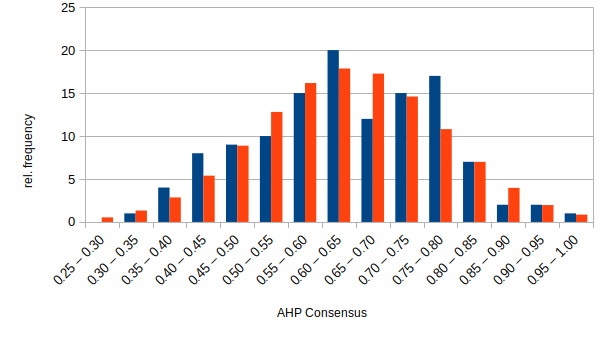The Analytic Hierarchy Process (AHP) is one of the multi-criteria decision making methods helping decision makers in rational decision making using a mathematical method. AHP as a practical tool can be especially helpful, when making group decisions.
Download (pdf):
Klaus D. Goepel, (2013). Implementing the Analytic Hierarchy Process as a Standard Method for Multi-Criteria Decision Making In Corporate Enterprises – A New AHP Excel Template with Multiple Inputs, Proceedings of the International Symposium on the Analytic Hierarchy Process 2013
Group Decision Making
Group decisions are often made because decision problems can become very complex by nature; they could require special expertise and complementing skills, as they cannot be provided by a single person. Another reason could be the wish to spread responsibility or to get a higher commitment from a team for necessary actions as a consequence of the decision to be made.
 There are different possible approaches to come to a decision. In the ideal case we get a consensus – an agreement through discussion and debate – but often a decision is a compromise. Group members readjust their opinions and give up some demands. Another way is a majority vote or a single leader’s final decision, based on his position and power.
There are different possible approaches to come to a decision. In the ideal case we get a consensus – an agreement through discussion and debate – but often a decision is a compromise. Group members readjust their opinions and give up some demands. Another way is a majority vote or a single leader’s final decision, based on his position and power.
In any case a possible disadvantage is that during group discussions a strong individual takes the lead, suppressing or ignoring others’ opinions and ideas (dominance), or people don’t want to speak up and conform to whatever is said (conformance).
Table 1: Reasons for group decision making and group decision approach
| Reasons for group decisions |
Group Decision Approach |
Special expertise
Subject matter experts
Complementing skills
Different viewpoints/departments
Spread of responsibility
Board, committee members
Higher commitment
Team decision |
Consensus
Agreement through discussion and debate
Compromise
Readjustment, giving up some – demands
Majority vote
Opinion of majority
Single leader’s final decision |
The Analytic Hierarchy Process (AHP) in Group Decision Making
When using AHP with its questionnaire, these problems can be avoided. Each member of the group has to make judgment by doing a pairwise comparison of criteria in the categories and subcategories of the hierarchical structured decision problem. Advantages are:
- It is a structured approach to find weights for criteria and sub-criteria in a hierarchically structured decision problem.
- All participants’ inputs count; no opinion or judgment is ignored and all group members have to fill-out the questionnaire.
- Participants’ evaluation can be weighted by predefined (and agreed) criteria, like expertise, responsibility, or others, to reflect the actual involvement of decision makers.
- The consolidated group result is calculated using a mathematical method; it is objective, transparent and reflects the inputs of all decision makers.
From practical experience, especially the last point results in a usually high acceptance of the group result. Aggregation of individual judgments (AIJ) in AHP can be done using the geometric mean: each matrix element of the consolidated decision matrix is the geometric mean of the corresponding elements of the decision makers’ individual decision matrices. The outcome – consolidated weights or priorities for criteria in a category – can be used as group result for the calculation of global priorities in the decision problem.
AHP Consensus Indicator
Although mathematically it is always possible to calculate a group result, the question remains, whether a calculated group result makes sense in all cases. For example, if you have two totally opposite judgments for two criteria, an aggregation will result in equal weights (50/50) for both criteria. In fact, there is no consensus, and equal weights may result in a deadlock situation to solve a decision problem.
Therefore, it will be necessary to analyze individual judgments, and find a measure of consensus for the aggregated group result. We use Shannon entropy and its partitioning in two independent components (alpha and beta diversity) to derive a new AHP consensus indicator. Originating from information theory, the concept of Shannon entropy is well established in biology for the measurement of biodiversity. Instead of relative abundance of species in different habitats, we analyse the priority distribution of criteria among different decision makers.
Further Reading, References and Examples of Practical Applications
The AHP consensus indicator is calculated in my free AHP Excel template. Group analysis by partitioning of Shannon entropy in alpha and beta entropy can be done by transferring the calculated priorities (AHP priority vector) from each decision maker to the BPMSG Diversity calculator.
Feedback and Comments are welcome!



 There are different possible approaches to come to a decision. In the ideal case we get a consensus – an agreement through discussion and debate – but often a decision is a compromise. Group members readjust their opinions and give up some demands. Another way is a majority vote or a single leader’s final decision, based on his position and power.
There are different possible approaches to come to a decision. In the ideal case we get a consensus – an agreement through discussion and debate – but often a decision is a compromise. Group members readjust their opinions and give up some demands. Another way is a majority vote or a single leader’s final decision, based on his position and power.